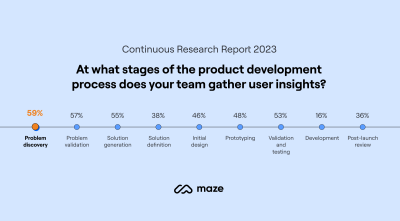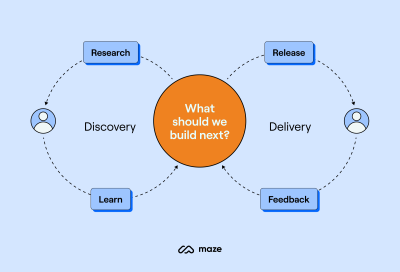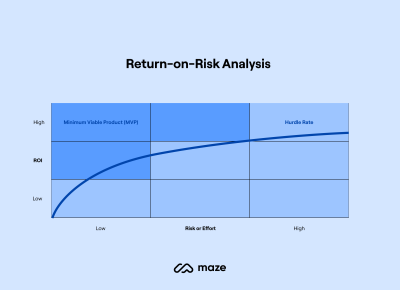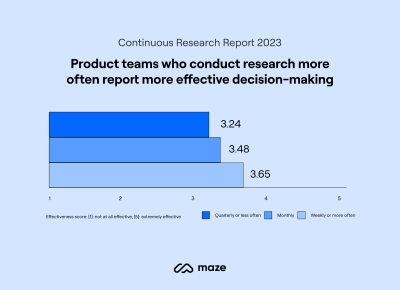Although you might be able to map out the development of a new product with a definitive start and end date, there really is no end point.
The most successful digital products are the ones continually being debugged, updated and enhanced. By extension, the most successful brands are ones that draw valuable lessons from the development of one product and apply it to other products as well as the organization as a whole.
Today, I’m going to dig into Maze’s Continuous Research Report: Trends to Watch in 2023. Developed in partnership with Atlassian, the report presents data from over 600 product professionals and explores how product teams conduct research to inform their decision-making.
In the following post, we’re going to explore the current state of product research, the trends shaping the future of the industry and the benefits of continuous discovery and research. Then we’ll look at some tips for making continuous discovery part of your process going forward.
The Current State of Product Research
A product doesn’t become successful simply because a great product team builds it and a savvy marketing team promotes it. A digital product has to be well-built, align with user expectations, and effectively solve their problems. It also needs to evolve over time as customer needs evolve.
This is why user input is so critical in the grand scheme of product development.
More and more organizations understand how valuable this data is, with 83% of Maze’s survey respondents agreeing that research should be conducted at every stage of product development.
However, data suggests that only 36% of digital product teams perform research post-launch. In addition, 60% connect with customers only once a month (if that), despite making product-related decisions on a daily basis.

Gathering user input during both the Discovery and Delivery phases is essential. Without user input early on, product teams end up building products based on generalizations, assumptions, and biases. Concrete data and feedback, on the other hand, provide product professionals with a clearer roadmap of what to build along with validation that what they’re building is on the right track.
Here’s what the continuous product discovery process looks like:

According to the report, 78% of respondents believe that their company isn’t doing enough research or could be doing it more frequently. When asked what’s keeping them from doing continuous discovery and research or doing enough of it, limitations related to time, budget, respondent recruitment and tooling were the most common reasons.
The good news is that companies are starting to involve users continuously throughout the product development process. One way they’re doing this is by democratizing research. In addition to researchers, designers (69%), product managers (54%), marketers (28%), and engineers (10%) conduct research at their companies.
By empowering every team to engage in research, product organizations can uncover customer needs and motivation and constantly improve their product as they build.
While there are still some challenges holding product teams back, continuous discovery and research is becoming a more established practice.
The Benefits of Doing Continuous Discovery and Research for Your Digital Products
We’ve all felt the strain that the above limitations can put on our work. To relieve that strain, we often look for ways to cut corners or to do without, at least for the time being.
But can you afford to cut corners when it comes to product research?
Let’s have a look at some of the things that happen when you perform continuous research on your product. Then you can decide if this is something you can afford to cut short or limit resources to.
1. Eliminate Assumptions in Product Decision-making
Rachel Lynch, the Research Manager for Productboard, had this to say about continuous discovery:
“Many research resources are being put into the design process, problem discovery and solution testing, but not so much into post-launch reviews. I think that’s a huge gap and a missed opportunity because you only know if something will work once you launch it. You should be using those same research tactics to try and figure out if you were successful once something has gone live.”
Data collection in the first stage of the product development journey can reveal a lot about your target users along with their needs, expectations and hesitations. It also helps you to uncover what you should be building.
However, a product is never really done. Because of this, there’s always more to discover about your product and users, which is why the process needs to extend throughout the entire development lifecycle.
The only way to ensure that you’re building the best products and experiences is to perform continuous research and gather meaningful insights from real users long after your product launches.
2. Keep Products in Sync with User Needs
According to Xiangyi Tang, the Head of User Research over at Pitch, continuous research allows products to remain valuable and useful to users over time:
“Product organizations need to truly understand their customers to be competitive. With continuous research, they can constantly course-correct to work on the right problem and provide the right solution.”
Users change over time. Brands change over time. So too do the products they build. It’s natural for user needs and desires to evolve. In some cases, it happens because of a shift in how the industry operates. In others, it’s because the industry or economy as a whole has been disrupted.
Take product organizations that build software for restaurants, for instance. The restaurant industry has gone through major changes over the past few years. If product organizations weren’t regularly reviewing market changes or conducting research with users, they might not have known how to keep their restaurant software products up to date or have been able to pivot sooner than the competition.
Continuous research is basically a form of active listening. By paying attention to how things are changing all around you and your product, you can proactively develop new features, pivot your product or develop new ones entirely in response to what you’re “hearing”.
3. Validate Your Concepts Before Development
A minimum viable product (MVP) is a scaled-back version of a product. Developers initially build it with just the core features that users need in order to use and derive value from it. It’s through the process of continuous research that product teams are able to validate and refine their product ideas pre-development.
Because of this methodical and iterative approach, an MVP greatly reduces how much time and money is spent developing a digital product. For instance, fixing an error after a product launch can cost up to 100 times more than if it’s caught during development.
Productboard has an illustration that perfectly sums up how a lower monetary investment in a product keeps risks low. And how the effort to recover from and rebuild a faulty product remains low as well.

This is one of the strongest arguments for doing research. You can save yourself so much wasted time and energy during initial product builds by focusing on developing core features that make the product usable and useful. Continuous research and testing will then allow you to naturally evolve a product into its best self.
4. Create More Satisfying User Experiences
With ongoing research, you can gather real-time insights and test new features that allow users to have more meaningful and valuable interactions with your product. This in turn translates to greater company success. Basing decisions on real user data — at the product, team and corporate level — ensures that customers’ needs are always at the center of what you’re building.
According to respondents, product research has a positive impact on:
- Customer satisfaction score (57%);
- Product/feature adoption (55%);
- Active users (46%);
- Revenue/profitability (42%).
Products informed by user input lead to greater customer satisfaction. Not only that, they hold onto their users for longer. This alone is good for boosting user satisfaction through product development. Long-term data gathered from the same user set can be much more meaningful than data from a steady stream of new and random users.
It’s also important to consider that satisfied long-time users cost much less to manage and maintain. This means you won’t have to spend as much time or effort on marketing to attract as many new customers.
Also, product bugs and security breaches are less likely to occur when you’re keeping a close eye on your product. This results in less money spent on putting out fires and dealing with PR fiascos.
5. Make More Effective Decisions Company-Wide
Data is valuable for organizations and their product teams.
According to Maze’s respondents, 74% of product professionals believe research is effective or partially effective in determining decision-making at their organizations, and 14% say it’s highly effective.
In particular, the report shows that product teams who conduct research more often (weekly or daily) report more effective decision-making than those who conduct research less often (quarterly or yearly).

Respondents also reported that this data can enable different types of decision-making. For instance:
- 42% of product professionals leverage data to inform all of their product decision-making.
- 49% of organizations use research findings to make strategic decisions.
- 60% of product professionals say that recommendations from research findings inspire new product opportunities.
It appears as though the research conducted on one product isn’t just valuable for the product in question but for the organization as a whole when it comes to making strategic decisions. And it’s even more valuable when it comes to inspiring new products.
Continuous research can have a positive impact on more than just product and executive leadership teams. Lucy Denton, the Head of Design at Dovetail, says:
“Today, research is really focused on understanding the user experience, which directly fits into the experience design of the product. It would be interesting to see how companies evolve to focus more on the customer in other functions like marketing, sales or customer support. They all talk to customers and need to understand the customers to do their job.”
By making this data readily available to the organization at large, imagine what it could do for sales, marketing and customer service. An ongoing stream of real user feedback could improve every aspect of the company.
How to Make Continuous Discovery Part of Your Process
In a recent interview, product discovery coach Teresa Torres explains how and why a continuous discovery mindset in product development is important today:
“Historically, businesses made discovery decisions by just sitting in a room and thinking ‘what should we build?’ Over the last 20 years, we’ve seen an evolution toward including the customer a lot more in the process.”
Human-centered design is what we’re all striving for today. The only way to ensure that products continue to meet and exceed user expectations is to gather continual feedback from them and test new hypotheses and concepts on them.
If you want to make continuous discovery part of your process, here are some tips to get you started:
Tip #1: Schedule Time for It
If you make time for it, then you’ll have no excuse not to do it. As for how much time you should devote to continuous discovery, the more frequently it’s done, the better.
According to Maze’s analysis, product teams doing research on a monthly or more frequent basis rated it as more effective than those who only did it quarterly or yearly. Teresa Torres suggests that weekly is best:
“At a minimum, weekly touchpoints with customers by the team building the product, where they’re conducting small research activities in pursuit of a desired product outcome.”
Block off a weekly recurring time for discovery. You can start with as little as 30 minutes before increasing the frequency of customer interactions.
Tip #2: Make It Part of Your Project Proposal
Research is a marathon that extends across the entire product life cycle. If you’re not in the habit of considering post-launch activities as part of your project proposal, timeline or budget, now is a good time to start doing so.
Research should never be considered an “extra” or an afterthought. By building it into your process from the beginning, you’ll ensure research is not seen as a set of individual studies but as a continuous learning cycle.
Tip #3: Implement the Right Research Tools
One of the biggest limitations product teams have in adopting a continuous mindset and approach is tooling.
The UX tools landscape has grown a lot in recent years. Each platform offers a unique collection of features and functionalities that product and UX researchers are looking for.
Maze, for instance, is a continuous product discovery platform that offers unified solutions for discovery — from prototype testing and surveys to card sorting and video recordings. You can also use it to recruit participants and generate automated reports for every piece of research you run.
The key is to find the right platforms for your product development lifecycle and the various research and testing methods you plan to use. Here are 13 UX research tools to explore now.
Tip #4: Mix-and-Match Methods
Just because there are dozens of types of product research and testing methods, that doesn’t mean you have to do them all in order to get meaningful results. The trick is to choose the right research methods — i.e. ones that help you reach your research goals more effectively. For instance:
Primary vs. Secondary:
- Primary data directly comes from your end users.
- Secondary data comes from already existing data related to the industry.
Qualitative vs. Quantitative:
- Qualitative data relates to the user’s opinions and feelings. This type of research is key to developing a deep understanding of a problem or uncovering the ‘why’ behind actions.
- Quantitative data relates to the statistical/numerical data gathered from users to answer research questions such as ‘what’, ‘where’ or ‘when’.
Evaluative vs. Generative:
- Evaluative research is used to evaluate a product or concept and collect data that helps improve your solutions.
- Generative research is used to develop a deep understanding of your users and the problem you’re trying to solve for them.
Using different types of research will give you a more well-rounded idea of what’s going on with your users and can make your research more cost-effective. Depending on your project objective and resources, for example, you can opt for more unmoderated studies and panels as opposed to moderated ones that require live control and monitoring in the data gathering sessions.
Tip #5: Get Everyone Involved
Everyone in your organization can benefit from and contribute to product research — for example: product managers, designers, marketers, salespeople, customer support representatives and so on. So why should a dedicated UX researcher or team be the only one to gather insights?
Caitlin McCurrie, the Research Lead at Atlassian, discusses why research democratization is a must to scale the impact of research:
“While I strongly believe that dedicated research professionals are a necessary component for a successful tech company, there will never be enough researchers to cover the range and volume of research needs within an organization. We will always need our teammates to engage in some form of research—whether collaborating with a dedicated researcher or running their own studies.”
It’s not just an issue of data volume. People in different roles will view the research from their unique perspectives, which can lead to additional discoveries and suggestions than you might otherwise get.
Wrapping Up
While a lot of product teams conduct research at the product discovery stage or validation and testing stage, only a few continue with the process after launch. However, think of all the benefits that come from doing product research. Now multiply those results by every time you connect with users to discover new ways to improve your product.
If you’d like more research on the benefits of continuous research, read the full Continuous Research Report from Maze now.
(vf, il)
